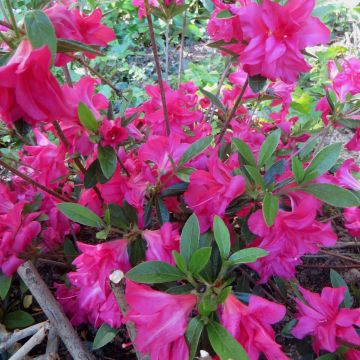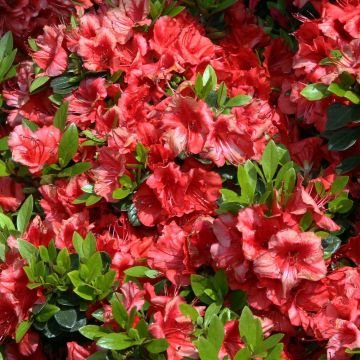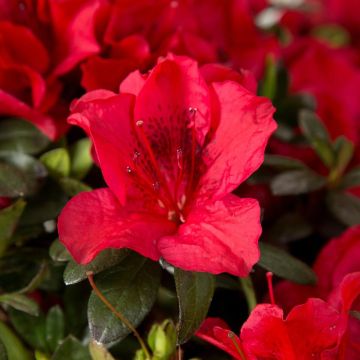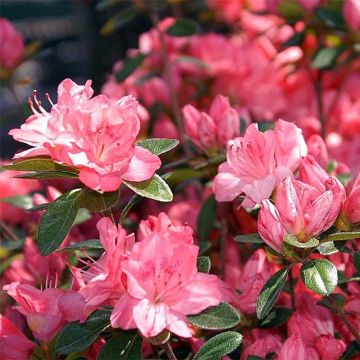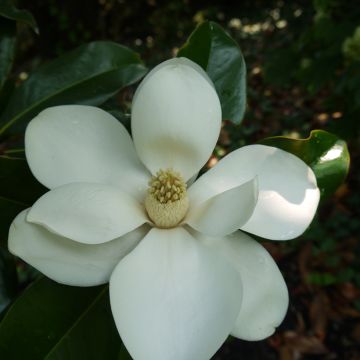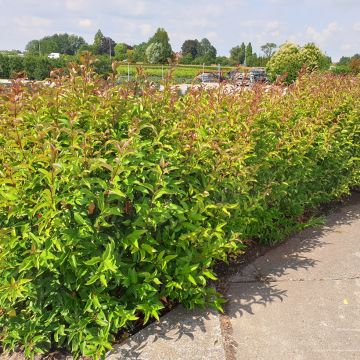

Azalée du Japon Adonis - Rhododendron hybride.


Azalée du Japon Adonis - Rhododendron hybride.
Azalea japonica Adonis
Rhododendron (Azalea) obtusum Adonis
Japanese Azalea
This item cannot be shipped to the selected country
Delivery charge from €5.90
More information
Schedule delivery date,
and select date in basket
This plant carries a 24 months recovery warranty
More information
We guarantee the quality of our plants for a full growing cycle, and will replace at our expense any plant that fails to recover under normal climatic and planting conditions.
From €5.90 for pickup delivery and €6.90 for home delivery
Express home delivery from €8.90.
Does this plant fit my garden?
Set up your Plantfit profile →
Description
The Japanese Azalea Adonis is a small evergreen ericaceous shrub descended from Rhododendron obtusum, belonging to the large Rhododendron family. With its naturally rounded, compact habit and abundant spring flowers, it is as ornamental in the garden as it is in a pretty pot on the terrace. Forming a perfect cushion of white flowers from April onwards, 'Adonis' is an excellent early-flowering white cultivar, both floriferous and resistant to cold. Give this Azalea the conditions it loves: a semi-shaded position and well-drained, lime-free soil that stays moist all year round. A must in any small Japanese garden!
The Rhododendron obtusum is now considered a hybrid of Rhododendron sataense, R. kiusinum and R. kaempferi. It is a mostly evergreen shrub of the heath or Ericaceae family. All these hardy plants, are native to Japan, China and Korea. They are characterised by early, dazzling spring flowers and foliage that is not entirely evergreen. There are 2 types of foliage on these azaleas, the spring foliage, which is fine and relatively wide, and the foliage that forms at the end of summer, which is tougher and smaller. The spring leaves fall off in autumn, while the majority of the leaves produced in late summer will last throughout the winter
'Adonis' is a small, naturally compact cultivar with a spreading, rounded habit, reaching about 60 cm (23.6 in) in height and 70-80 cm (27.6-31.5 in) in spread. Its blooms last for about 3 weeks, usually in April, depending on the climate. The large pure-white, trumpet-shaped flowers are gathered in generous terminal clusters that almost completely hide the foliage which consists of single, oval-lanceolate leaves with smooth edges, arranged alternately on the branches. They vary from 5 to 10 cm (2 to 3.9 inches) in length, and they are fairly light green, with a satiny finish. Azaleas and Rhododendrons have a shallow root system that always needs to be kept moist, but they also dislike waterlogged soil which would suffocate the roots.
Japanese Azaleas thrive in cool climates with distinct winters, planted in humus-rich, ericaceous soil. They are very beautiful evergreen shrubs for borders or containers, attractive all year round. They are a perfect accompaniment to heathers, Japanese maples, or their relatives, Chinese Azaleas, which change colour with the seasons. They can also be combined with Japanese camellias, and their graceful, often fragrant, autumn-flowering cousins, the Camellia sasanqua hybrids. This Adonis variety will look wonderful on a terrace or balcony, in a large, carefully chosen pot with suitable compost and lime-free water for watering.
Report an error about the product description
Azalea japonica Adonis in pictures


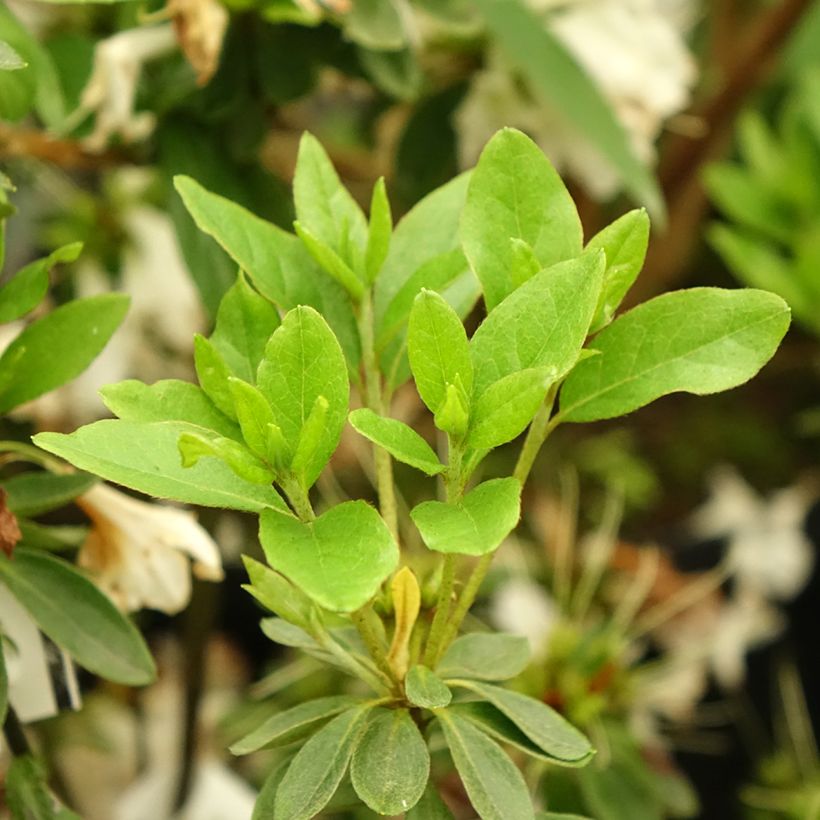

Plant habit
Flowering
Foliage
Botanical data
Rhododendron (Azalea)
obtusum
Adonis
Ericaceae
Japanese Azalea
Cultivar or hybrid
Other Japanese Azalea
Planting and care
The Japanese Azalea thrives a rather shady location unlike the Chinese Azalea, but its preferred position is in semi-shade. Plant it in an ericaceous or humus-rich, well-drained and lime-free soil. Make sure not to plant the root ball too deep, it should be level with the surface of the soil. Water copiously with alkaline-free water during dry periods, at least once a week in the first year. In spring, apply a fertilizer for ericaceous plants. Pruning is not essential but it is a good idea to prune lightly after flowering to keep the plant looking neat. Remove spent flowers to encourage new growth. The Azalea suffers from very few diseases when well-established outdoors. It can be attacked by weevils that eat the edges of the leaves and rootlets, and by the famous "Rhododendron lace bug", though not often causing significant damage. If the soil is chalky or poorly drained, or if the rootball is too deep, the leaves may turn yellow and eventually die.
Japanese azaleas thrive in cool and humid climates, they are generally very hardy but dislike dry air and dry soil.
Planting period
Intended location
Care
-
, onOrder confirmed
Reply from on Promesse de fleurs
Evergreen shrubs
Haven't found what you were looking for?
Hardiness is the lowest winter temperature a plant can endure without suffering serious damage or even dying. However, hardiness is affected by location (a sheltered area, such as a patio), protection (winter cover) and soil type (hardiness is improved by well-drained soil).

Photo Sharing Terms & Conditions
In order to encourage gardeners to interact and share their experiences, Promesse de fleurs offers various media enabling content to be uploaded onto its Site - in particular via the ‘Photo sharing’ module.
The User agrees to refrain from:
- Posting any content that is illegal, prejudicial, insulting, racist, inciteful to hatred, revisionist, contrary to public decency, that infringes on privacy or on the privacy rights of third parties, in particular the publicity rights of persons and goods, intellectual property rights, or the right to privacy.
- Submitting content on behalf of a third party;
- Impersonate the identity of a third party and/or publish any personal information about a third party;
In general, the User undertakes to refrain from any unethical behaviour.
All Content (in particular text, comments, files, images, photos, videos, creative works, etc.), which may be subject to property or intellectual property rights, image or other private rights, shall remain the property of the User, subject to the limited rights granted by the terms of the licence granted by Promesse de fleurs as stated below. Users are at liberty to publish or not to publish such Content on the Site, notably via the ‘Photo Sharing’ facility, and accept that this Content shall be made public and freely accessible, notably on the Internet.
Users further acknowledge, undertake to have ,and guarantee that they hold all necessary rights and permissions to publish such material on the Site, in particular with regard to the legislation in force pertaining to any privacy, property, intellectual property, image, or contractual rights, or rights of any other nature. By publishing such Content on the Site, Users acknowledge accepting full liability as publishers of the Content within the meaning of the law, and grant Promesse de fleurs, free of charge, an inclusive, worldwide licence for the said Content for the entire duration of its publication, including all reproduction, representation, up/downloading, displaying, performing, transmission, and storage rights.
Users also grant permission for their name to be linked to the Content and accept that this link may not always be made available.
By engaging in posting material, Users consent to their Content becoming automatically accessible on the Internet, in particular on other sites and/or blogs and/or web pages of the Promesse de fleurs site, including in particular social pages and the Promesse de fleurs catalogue.
Users may secure the removal of entrusted content free of charge by issuing a simple request via our contact form.
The flowering period indicated on our website applies to countries and regions located in USDA zone 8 (France, the United Kingdom, Ireland, the Netherlands, etc.)
It will vary according to where you live:
- In zones 9 to 10 (Italy, Spain, Greece, etc.), flowering will occur about 2 to 4 weeks earlier.
- In zones 6 to 7 (Germany, Poland, Slovenia, and lower mountainous regions), flowering will be delayed by 2 to 3 weeks.
- In zone 5 (Central Europe, Scandinavia), blooming will be delayed by 3 to 5 weeks.
In temperate climates, pruning of spring-flowering shrubs (forsythia, spireas, etc.) should be done just after flowering.
Pruning of summer-flowering shrubs (Indian Lilac, Perovskia, etc.) can be done in winter or spring.
In cold regions as well as with frost-sensitive plants, avoid pruning too early when severe frosts may still occur.
The planting period indicated on our website applies to countries and regions located in USDA zone 8 (France, United Kingdom, Ireland, Netherlands).
It will vary according to where you live:
- In Mediterranean zones (Marseille, Madrid, Milan, etc.), autumn and winter are the best planting periods.
- In continental zones (Strasbourg, Munich, Vienna, etc.), delay planting by 2 to 3 weeks in spring and bring it forward by 2 to 4 weeks in autumn.
- In mountainous regions (the Alps, Pyrenees, Carpathians, etc.), it is best to plant in late spring (May-June) or late summer (August-September).
The harvesting period indicated on our website applies to countries and regions in USDA zone 8 (France, England, Ireland, the Netherlands).
In colder areas (Scandinavia, Poland, Austria...) fruit and vegetable harvests are likely to be delayed by 3-4 weeks.
In warmer areas (Italy, Spain, Greece, etc.), harvesting will probably take place earlier, depending on weather conditions.
The sowing periods indicated on our website apply to countries and regions within USDA Zone 8 (France, UK, Ireland, Netherlands).
In colder areas (Scandinavia, Poland, Austria...), delay any outdoor sowing by 3-4 weeks, or sow under glass.
In warmer climes (Italy, Spain, Greece, etc.), bring outdoor sowing forward by a few weeks.

































